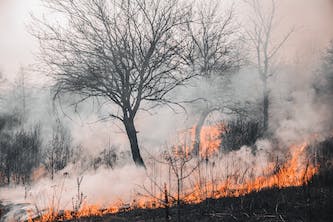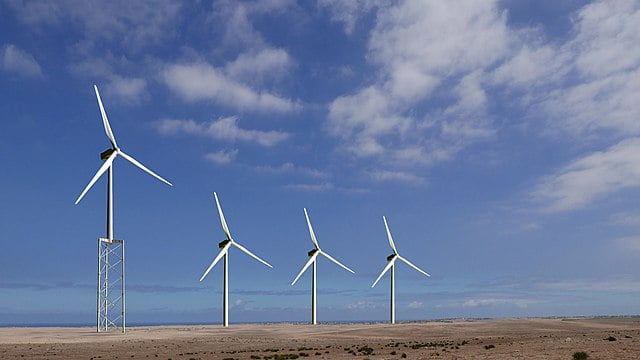Scientists say that because our world is getting warmer, there might be more lightning in the big woods where it is usually cold. This could start more fires, which is bad because the big woods help keep our planet cool. The big woods are like a big blanket that stops the air from getting too hot. But if there are more fires, the blanket gets holes and can’t work as well. This summer, a lot of fires happened in Canada and burned a lot of trees and land.
The scientists used special computer brains to make a map that shows where fires start. They saw that lightning starts most fires in the big cold woods. If there are more fires, it makes the air even hotter, which can make even more lightning and fires. This is like a big circle that keeps going and making things worse. The scientists say we need to work hard to stop the world from getting too hot so that there won’t be as much lightning and fires in the big woods.
Original news source: Lightning fires threaten planet-cooling forests (BBC)
Listen
Slow
Normal
Fast
Group or Classroom Activities
Warm-up Activities:
– Vocabulary Pictionary
Instructions: Divide the class into two teams. Use a whiteboard or large paper, and draw pictures to represent words from the article such as “world,” “lightning,” “woods,” “fires,” “blanket,” “hot,” and “circle.” Teams must guess the word being drawn. If a team guesses correctly, they earn a point. The team with the most points at the end wins. This helps students associate words with images, aiding vocabulary retention.
– News Reporter Role-play
Instructions: Pair up the students and assign them roles: one as a news reporter and the other as a scientist. The reporter should ask questions about the article’s content, such as “Why are there more fires?” or “How do the big woods help our planet?” The scientist responds with information from the article. This allows students to practice speaking and listening using the context of the article.
– Think-Pair-Share
Instructions: Have students think about the question “Why are the big woods important?” for a minute on their own. Then, pair them up to discuss their ideas. Finally, bring the class together and have a few pairs share their thoughts with everyone. This activity encourages students to communicate their ideas and build confidence in speaking.
– Sketch It
Instructions: Give each student a piece of paper and ask them to draw the big circle of events described in the article: the world getting hotter, more lightning, fires in the big woods, and the circle continuing. After they finish drawing, ask them to label each part of their sketch in English. This visual representation helps with understanding the sequence of events and the cause-and-effect relationship.
– Headline Creation
Instructions: Ask students to create a catchy headline for the article that would grab someone’s attention. Explain that a good headline summarizes the main point and is exciting to read. After they come up with their headlines, have a few students share them with the class. This helps with understanding the main idea and encourages creativity in language use.
Comprehension Questions:
1. What is happening to our world that might make more lightning?
2. Where might there be more lightning because our world is getting warmer?
3. Why are fires in the big woods bad for our planet?
4. What do the big woods do for the air?
5. What happened this summer in Canada?
6. How did the scientists find out where fires start?
7. What do the scientists say we need to do to have less lightning and fires?
Go to answers ⇩
Listen and Fill in the Gaps:
Scientists say that because our world is (1)______ warmer, there might be more lightning in the big woods where it is usually cold. This could start more fires, which is bad because the big woods help keep our planet (2)______. The big woods are like a big blanket that stops the air from getting too hot. But if there are more fires, the blanket gets (3)______ and can’t work as well. This summer, a lot of fires happened in Canada and burned a lot of trees and (4)______.
The scientists used special computer brains to make a map that shows where fires start. They saw that lightning starts most fires in the big cold (5)______. If there are more fires, it makes the air even (6)______, which can make even more lightning and fires. This is like a big circle that keeps going and making things worse. The scientists say we need to (7)______ hard to stop the world from getting too hot so that there won’t be as much (8)______ and fires in the big woods.
Go to answers ⇩
Discussion Questions:
Students can ask a partner these questions, or discuss them as a group.
1. What is lightning?
2. Do you like watching lightning in the sky? Why or why not?
3. Have you ever seen a big fire? How did it make you feel?
4. What is a forest (big woods)?
5. Why do you think trees are important?
6. How do you feel when it gets very hot outside?
7. What can you do to help keep our world cool?
8. Do you think it’s important to stop fires? Why or why not?
9. Have you ever been to a place where it is usually very cold? What was it like?
10. Do you think scientists should tell people how to stop the world from getting too hot? Why?
11. Can you think of a time when you helped stop something bad from happening? What did you do?
12. Do you think more lightning is a good thing or a bad thing? Why?
Individual Activities
Vocabulary Meanings:
Match each word to its meaning.
Words:
1. lightning
2. fires
3. blanket
4. planet
5. map
6. circle
7. scientists
8. computer
Meanings:
(a) A picture that shows where things are
(b) Something that keeps you warm in bed
(c) People who study things and do experiments
(d) Something that burns and makes smoke
(e) A big flash in the sky during a storm
(f) The world we live on
(g) A round shape that keeps going around
(h) A machine that helps you do math and play games
Go to answers ⇩
Multiple Choice Questions:
1. Why are scientists worried about more lightning in the big woods?
(a) It could make the air smell bad
(b) It could make the trees grow faster
(c) It could start more fires
(d) It could make the animals run away
2. What do the big woods help keep our planet?
(a) Cool
(b) Warm
(c) Wet
(d) Dry
3. What did the scientists use to make a map that shows where fires start?
(a) Special pencils
(b) Special books
(c) Special toys
(d) Special computer brains
4. What starts most fires in the big cold woods?
(a) Rain
(b) Snow
(c) Wind
(d) Lightning
5. What happens if there are more fires in the big woods?
(a) The air gets cooler
(b) The air gets even hotter
(c) The animals have more fun
(d) The trees grow taller
6. What can make even more lightning and fires?
(a) The air getting colder
(b) The air getting hotter
(c) The rain falling
(d) The wind blowing
7. What do the scientists say we need to work hard to stop?
(a) The world from getting too hot
(b) The world from getting too cold
(c) The world from getting too wet
(d) The world from getting too dry
8. What is the big woods compared to in the article?
(a) A big hat
(b) A big shoe
(c) A big blanket
(d) A big book
Go to answers ⇩
True or False Questions:
1. Scientists used regular computer brains to make a map that shows where fires start.
2. More fires in the big woods can make the blanket of trees get holes and not work as well.
3. Lightning starts few fires in the big warm woods, which can make the air even cooler.
4. Lightning cannot start fires in the big woods, which is good because the woods help keep the planet cool.
5. The big woods are like a big blanket that stops the air from getting too hot.
6. The world is getting cooler, and this might cause less lightning in the warm big fields.
7. Many fires happened in Canada this summer and burned a lot of trees and land.
8. The scientists say we need to work hard to stop the world from getting too hot to prevent more lightning and fires in the big woods.
Go to answers ⇩
Write a Summary:
Write a summary of this news article in two sentences.
Writing Questions:
Answer the following questions. Write as much as you can for each answer.
1. Why are scientists worried about the big woods?
2. What happens when the world gets warmer?
3. What can start fires in the big woods?
4. Why are the big woods like a big blanket?
5. What do scientists say we need to do to help the big woods?
Answers
Comprehension Question Answers:
1. What is happening to our world that might make more lightning?
Our world is getting warmer, and that can make more lightning.
2. Where might there be more lightning because our world is getting warmer?
There might be more lightning in the big woods where it is usually cold.
3. Why are fires in the big woods bad for our planet?
Fires in the big woods are bad because the woods help stop the air from getting too hot, and fires make holes in this blanket.
4. What do the big woods do for the air?
The big woods are like a big blanket that stops the air from getting too hot.
5. What happened this summer in Canada?
This summer in Canada, a lot of fires happened and burned many trees and land.
6. How did the scientists find out where fires start?
Scientists used special computer brains to make a map that shows where fires start.
7. What do the scientists say we need to do to have less lightning and fires?
The scientists say we need to work hard to stop the world from getting too hot so there won’t be as much lightning and fires.
Go back to questions ⇧
Listen and Fill in the Gaps Answers:
(1) getting
(2) cool
(3) holes
(4) land
(5) woods
(6) hotter
(7) work
(8) lightning
Go back to questions ⇧
Vocabulary Meanings Answers:
1. lightning
Answer: (e) A big flash in the sky during a storm
2. fires
Answer: (d) Something that burns and makes smoke
3. blanket
Answer: (b) Something that keeps you warm in bed
4. planet
Answer: (f) The world we live on
5. map
Answer: (a) A picture that shows where things are
6. circle
Answer: (g) A round shape that keeps going around
7. scientists
Answer: (c) People who study things and do experiments
8. computer
Answer: (h) A machine that helps you do math and play games
Go back to questions ⇧
Multiple Choice Answers:
1. Why are scientists worried about more lightning in the big woods?
Answer: (c) It could start more fires
2. What do the big woods help keep our planet?
Answer: (a) Cool
3. What did the scientists use to make a map that shows where fires start?
Answer: (d) Special computer brains
4. What starts most fires in the big cold woods?
Answer: (d) Lightning
5. What happens if there are more fires in the big woods?
Answer: (b) The air gets even hotter
6. What can make even more lightning and fires?
Answer: (b) The air getting hotter
7. What do the scientists say we need to work hard to stop?
Answer: (a) The world from getting too hot
8. What is the big woods compared to in the article?
Answer: (c) A big blanket
Go back to questions ⇧
True or False Answers:
1. Scientists used regular computer brains to make a map that shows where fires start. (Answer: False)
2. More fires in the big woods can make the blanket of trees get holes and not work as well. (Answer: True)
3. Lightning starts few fires in the big warm woods, which can make the air even cooler. (Answer: False)
4. Lightning cannot start fires in the big woods, which is good because the woods help keep the planet cool. (Answer: False)
5. The big woods are like a big blanket that stops the air from getting too hot. (Answer: True)
6. The world is getting cooler, and this might cause less lightning in the warm big fields. (Answer: False)
7. Many fires happened in Canada this summer and burned a lot of trees and land. (Answer: True)
8. The scientists say we need to work hard to stop the world from getting too hot to prevent more lightning and fires in the big woods. (Answer: True)
Go back to questions ⇧












